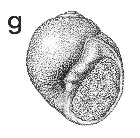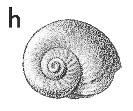
Revised descriptions of New Zealand Cenozoic Mollusca from Beu and Maxwell (1990)

 | Revised descriptions of New Zealand Cenozoic Mollusca from Beu and Maxwell (1990) | 
|
  (Pl. 27g): holotype, GS1366, Y17/f6486, alternating sandstone and siltstone in cutting on highway (now State Hwy 2) one to two km west of Te Karaka, Gisborne, Clifdenian (TM3783, GNS) |
  (Pl. 27h): holotype, GS1366, Y17/f6486, alternating sandstone and siltstone in cutting on highway (now State Hwy 2) one to two km west of Te Karaka, Gisborne, Clifdenian (TM3783, GNS) |
Beu & Maxwell (1990): Chapter 12; p. 245; pl. 27 g,h.
Synonymy: Uberella cicatrix Marwick 1931, p. 100; Beu & Maxwell 1990, p. 245, pl. 27g, h; Pliconacca cicatrix, Majima 1989, p. 65
Classification: Naticidae: Poliniceinae
Description: Very small for family (height 6.4 mm, diameter 5.5 mm), oval with whorl outlines slightly flattened, almost smooth, with very low spire. Sculpture of consistent, short, shallow axial grooves below suture on spire, becoming weak on last whorl, parallel to outer lip, which is prosocline below, then curves in to suture at little more than a right angle. Inner lip with moderately thickened callus, bearing single central denticle; umbilicus almost completely closed in most specimens, a few specimens with an extremely narrow chink.
Comparison: The species grop of "Uberella" cicatrix and the Nukumaruan-Recent species "U". denticulifera were referred to Pliconacca Cossmann & Martin in Martin, 1914 by Majima (1989, pp. 63, 65) (type species: Natica (Pliconacca) trisulcata Martin, 1914, Late Eocene, Java). Pliconacca is "characterised by the presence of 2 or 3 transverse callus grooves or depressions" on the umbilical/inner lip callus (Majima 1989, p. 63). The grooves are absent from Uberella species. Pliconacca cicatrix was apparently succeeded by P. cicatricella (Opoitian-Mangapanian), which differs in its slightly higher spire, its less laterally flattened whorls, its finer, more numerous and more closely spaced subsutural axial grooves, and its more consistently (if very narrowly) open umbilicus. P. cicatricella appears to be intermediate between P. cicatrix and the Nukumaruan to Recent species P. denticulifera, which differs from its presumed ancestors in its slightly larger size (to 9 mm high), its taller spire, its only weak signs of axial subsutural grooves, and its slightly more open umbilicus. Although P. cicatrix seems to be exclusively a bathyal species, its apparent descendants seem both to be both shelf and upper bathyal species, and P. denticulifera, for example, is much more common at Castlecliff, Wanganui, in offshore siltstone of the Okehu and Kai-Iwi Groups (Castlecliffian, shelf facies) than is the modern shallow-water species Uberella vitrea.
Distribution: Otaian-Tongaporutuan; Kapitean?, Te Karaka, Gisborne, Clifdenian (type). Present in most Miocene bathyal faunules throughout New Zealand, of Otaian (Parengarenga Harbour only) and Altonian to Tongaporutuan age, but not in the Waiauan faunules from the Stillwater Mudstone described by Maxwell (1988a).
Cite this publication as: "A.G. Beu and J.I. Raine (2009). Revised
descriptions of New Zealand Cenozoic Mollusca from Beu and Maxwell (1990). GNS
Science miscellaneous series no. 27."
© GNS Science, 2009
ISBN
978-0-478-19705-1
ISSN 1177-2441
(Included with a PDF facsimile file
copy of New Zealand Geological Survey Paleontological Bulletin 58 in CD version
from: Publications Officer, GNS Science, P.O. Box 30368 Lower Hutt, New
Zealand)